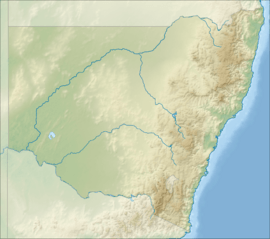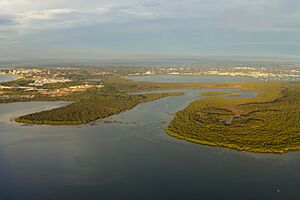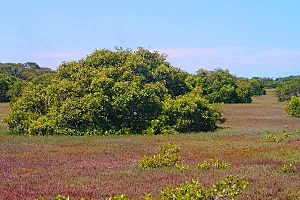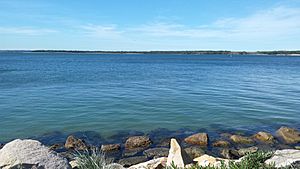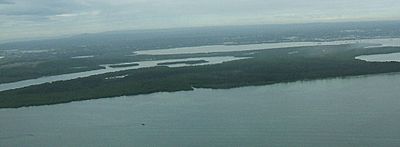Towra Point Nature Reserve facts for kids
Quick facts for kids Towra Point Nature ReserveNew South Wales |
|
|---|---|
|
IUCN Category Ia (Strict Nature Reserve)
|
|
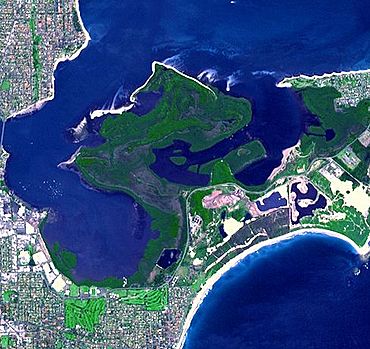
Aerial photograph of Towra Point and surrounding waters.
|
|
| Nearest town or city | Kurnell |
| Established | August 1982 |
| Area | 6.03 km2 (2.3 sq mi) |
| Managing authorities | NSW National Parks and Wildlife Service |
| Website | Towra Point Nature Reserve |
| Footnotes | |
| Official name: Towra Point | |
| Designated: | 21 February 1984 |
| Reference #: | 286 |
| See also | Protected areas of New South Wales |
The Towra Point Nature Reserve is a special protected area in Sutherland Shire, southern Sydney, New South Wales, Australia. This reserve covers about 603 hectares (about 1,490 acres). It is located on the southern side of Botany Bay near Kurnell.
Towra Point is very important because it is protected under the Ramsar Convention. This means it is a wetland that is recognized worldwide for its importance. It is a crucial breeding ground for many animals that are rare, protected, or in danger. The water areas around Towra Point are also protected as the Towra Point Aquatic Nature Reserve.
Contents
History of Towra Point Reserve
For a very long time, the Dharawal people lived in the Kurnell area, including Towra Point. You can still find signs of their history there, like ancient shell piles called middens.
Early European Settlement and Challenges
When James Cook explored Botany Bay in 1770, he mapped Towra Point. Early European settlers tried to raise horses and cattle here. But the land was not good for farming. In 1861, Thomas Holt bought Towra Point. He tried to farm sheep, but thousands died because the land was too wet. Later, in the 1870s, he started oyster farming in Weeney Bay.
Over the years, there were plans to use Towra Point for other things. In 1935, people stopped a plan to mine shells there. During World War II, a radar station was built. After the war, in 1946, Towra Point was even considered as a place for a second Sydney airport.
Protecting Towra Point from Development
In the 1960s, people started working to protect Towra Point. Local leaders like Arthur Gietzelt and Tom Uren pushed for its preservation. In 1969, Prime Minister John Gorton decided against building an airport there due to noise concerns.
In the 1970s, the entrance to Botany Bay was dug deeper for ships. This changed the waves in the bay, causing parts of Towra Point to erode. Strong waves even allowed teens to surf there in 1974 and 1975.
Becoming a Nature Reserve and Facing Threats
In 1975, the Australian government bought the reserve to protect it. This was the first time the government bought land in a state just for nature. In 1979 and 1981, oil spills in Botany Bay damaged the mangroves at Towra Point.
Finally, in 1982, Towra Point was officially made a nature reserve. In 1984, it became a Ramsar site, meaning it was recognized as a wetland of international importance. In 1987, the Towra Point Aquatic Nature Reserve was created to protect the surrounding waterways.
Ongoing Conservation Efforts
By 1990, erosion was a big problem. A part of Towra Point called the "Elephant's Trunk" broke off into an island. Trees along Towra Beach were falling into the water.
In 1997, a volunteer group called "Friends of Towra Point" was formed. They help by planting new plants, collecting seeds, and creating safe places for birds like the little tern. They also help with Clean Up Australia Day.
To fight erosion, sand was added to Towra Point in 2003. In 2004, a project separated Towra Spit Island from the main land to create a safe, fox-free environment for birds. Since 2007, the La Perouse Aboriginal Community has helped manage the area, combining modern conservation with traditional Aboriginal skills.
In 2012, Towra Point received a "Grey Globe" award. This award is given to Ramsar sites that are considered to be in danger. In 2013, Towra Point Nature Reserve was listed on the New South Wales State Heritage Register, recognizing its important history and natural value.
Habitats at Towra Point
Towra Point sits on an old river delta. It has many different types of natural areas, called habitats. These diverse habitats are why Towra Point is so important and why it's a Ramsar site.
The main habitats you can find in the reserve are:
- Salt marshes: Grassy areas that are flooded by salty water.
- Mangroves: Trees and shrubs that grow in salty coastal water.
- Littoral rainforests: Forests found near the coast.
- Turpentine forests: Forests with specific types of trees.
- Lagoons: Shallow bodies of water separated from the sea.
- Beaches: Sandy or pebbly shores.
The mangrove forests here are mostly made up of grey mangroves. You can also find river mangroves growing closer to the land.
Species Living in Towra Point
Towra Point Nature Reserve is home to many different animals and plants. Some of these species are endangered, vulnerable, or protected. This means they need special care to survive.
Birds of Towra Point
Many types of birds live in or visit Towra Point. It's especially important for migratory birds that travel long distances.
Amphibians of Towra Point
Amphibians like frogs need both water and land to live. Here are some found at Towra Point:
Mammals of Towra Point
Mammals are warm-blooded animals with fur or hair. Some common and some less common mammals live here:
- Dingo
- Dog
- Fox
- Dugong
- Rabbit
- House mouse
- Brown rat
- Black rat
- Cat
- Common brushtail possum
- Grey-headed flying fox
- Lesser long-eared bat
- Greater broad-nosed bat
- Little forest bat
Reptiles of Towra Point
Reptiles are cold-blooded animals, often with scales. Many different types of lizards and snakes call Towra Point home:
- Jacky lashtail
- Eastern snake-necked turtle
- Red-bellied black snake
- Eastern small-eyed snake
- Black-bellied swamp snake
- Dark-flecked garden sunskink
- Pale-flecked garden sunskink
- Yellow-bellied three-toed skink
- Eastern bluetongue
- Robust ctenotus
- Eastern water-skink
- Barred-sided skink
- Weasel skink
Plants of Towra Point
The reserve has a wide variety of plants, including native and some introduced species:
- Grey mangrove
- Sickle fern
- New Zealand spinach
- Parrot alstroemeria
- Fennel
- Moth vine
- Milk vine
- Common silkpod
- Fruit salad plant
- Arum lily
- English ivy
- Asparagus fern
- Bridal creeper
- Crofton weed
- Cobbler's pegs
- Boneseed
- Bitou bush
- Swamp oak
- Native wandering jew
- Tree broom-heath
- Coffee bush
- Wombat berry
- Port Jackson fig/rusty fig
- Cockspur thorn
- Muttonwood
- Swamp paperbark
- Broad-leaved paperbark
- Pixie caps
- Inkweed
- Sweet pittosporum
- Pampas grass
- Panic veldtgrass
- Rambling dock
- Coastal banksia
- Tuckeroo
- Slender grape
- Lantana
- Nightshade
- Black-berry
- Wild olive
- Samphire
- Magenta lilly pilly
How Humans Affect Towra Point
The natural environment around Towra Point has been changed by human activities. These changes can be good or bad.
Positive Human Effects on the Reserve
People are working to protect and restore the healthy wetlands at Towra Point. Here are some ways they do this:
- Limiting Access: Managers often allow public access only to small, specific areas. They use boardwalks and pathways to keep people from walking in sensitive parts of the reserve. Sometimes, you need a permit to visit certain areas.
- Education: In the past, wetlands were not always valued. Now, education helps people understand how important they are. Programs include guided tours, school visits, and information signs.
- Direct Action: Managers remove harmful things like foxes, rabbits, and weeds. For example, they remove weeds from Weedy Pond.
- Smart Design: Some designs help protect the area. At Towra Point Beach, a sandbag wall helps stop saltwater from getting into the freshwater Towra Lagoon.
- Laws and Agreements: Laws and international agreements help protect Towra Point. Australia has signed agreements like the Ramsar Convention, which protects wetlands worldwide. Other agreements like JAMBA and CAMBA protect birds that migrate between countries.
Negative Human Effects on the Reserve
Unfortunately, human activities can also harm Towra Point:
- Changed Water Flow: Building roads can change how water flows into the wetlands.
- Pollution: Urban and industrial areas nearby can cause dirty water and toxins to flow into the mangroves.
- Loss of Habitat: Wetlands can be replaced by parks or other developments.
- Damaged Seagrass: Boats and other activities can destroy seagrass beds, which are important for the ecosystem.
- Introduced Species: Animals like foxes, rabbits, and cats, which are not native to Australia, can harm local wildlife, especially birds like the little tern.
- Oil Spills: The nearby Kurnell Refinery has had oil spills in the past, which severely damaged the mangroves.
- Recreational Use: Activities like horse riding, dog walking, boating, and fishing can disturb wildlife and cause pollution.
- Erosion: The Sydney Airport runway has changed wave patterns, causing erosion at Towra Beach and making the freshwater lagoon salty.
- Rubbish Dumping: People sometimes dump rubbish, including dangerous materials like asbestos, in or near the reserve.
- Land Changes: Mining sand dunes in the past has made the land less stable. Strong storms could cause parts of the point to break off.
- Runoff: Water flowing from urban and industrial areas carries pollution into the reserve.
Managing the Reserve Today
Modern Management Goals
Today, the main goals for managing wetlands like Towra Point are to protect them and use them wisely for recreation, conservation, and education. This might mean some areas are closed off, but many are open for people to visit and learn.
Working Together to Protect Towra Point
Managing a complex area like Towra Point involves many different groups. These groups are called "stakeholders." For Towra Point, these include:
- The NSW National Parks & Wildlife Service
- NSW Fisheries
- Sutherland Shire Council
- The "Friends of Towra Point" volunteer group
- People who visit the reserve for fun
These groups work together to create management plans. These plans need to be flexible and adapt to new scientific discoveries, changing public opinions, and different levels of funding. They also must follow Australia's international agreements, like those for Ramsar, JAMBA, and CAMBA.
Laws Protecting Towra Point
Many laws and agreements help protect Towra Point Nature Reserve.
International Agreements
These are agreements between countries to protect important natural areas:
- Ramsar Convention (1971): Protects wetlands of international importance.
- JAMBA (1981): Protects birds that migrate between Japan and Australia.
- Bonn Convention (1983): Protects migratory wild animals.
- CAMBA (1988): Protects birds that migrate between China and Australia.
- ROKAMBA (2006): Protects birds that migrate between the Republic of Korea and Australia.
- Partnership for the Conservation of Migratory Waterbirds and the Sustainable Use of their Habitats in the East Asian–Australasian Flyway (2006): A partnership to protect migratory waterbirds in Asia and Australia.
- Convention on Biological Diversity (1992): A worldwide agreement to protect biodiversity.
Australian Laws
Because Towra Point is a Ramsar site, it is protected by Australia's federal Environment Protection and Biodiversity Conservation Act 1999. This law makes it a crime to do anything that significantly harms a Ramsar wetland. Towra Point is also part of a critically endangered ecological community called "Littoral Rainforest and Coastal Vine Thickets of Eastern Australia."
New South Wales Laws
New South Wales also has laws to protect Towra Point, such as:
- National Parks and Wildlife Act 1974 (NSW)
- Environmental Planning and Assessment Act 1979 (NSW)
- Fisheries Management Act 1994 (NSW)
- Threatened Species Conservation Act 1995 (NSW)
Towra Point Nature Reserve is also listed as part of the "Coastal Dune Littoral Rainforest" ecological community, which is an endangered community under the NSW Threatened Species Conservation Act.


